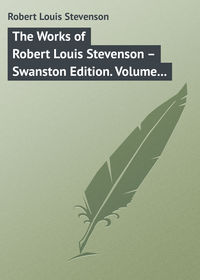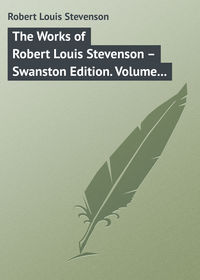 полная версия
полная версияThe Works of Robert Louis Stevenson – Swanston Edition. Volume 16
In this manner these four principal beams were erected, and left in a pretty secure state. The men had commenced while there was about two or three feet of water upon the side of the beacon, and as the sea was smooth they continued the work equally long during flood-tide. Two of the boats being left at the rock to take off the joiners, who were busily employed on the upper parts till two o’clock p.m., this tide’s work may be said to have continued for about seven hours, which was the longest that had hitherto been got upon the rock by at least three hours.
When the first boats left the rock with the artificers employed on the lower part of the work during the flood-tide, the beacon had quite a novel appearance. The beams erected formed a common base of about thirty-three feet, meeting at the top, which was about forty-five feet above the rock, and here half a dozen of the artificers were still at work. After clearing the rock the boats made a stop, when three hearty cheers were given, which were returned with equal goodwill by those upon the beacon, from the personal interest which every one felt in the prosperity of this work, so intimately connected with his safety.
All hands having returned to their respective ships, they got a shift of dry clothes and some refreshment. Being Sunday, they were afterwards convened by signal on board of the Lighthouse yacht, when prayers were read; for every heart upon this occasion felt gladness, and every mind was disposed to be thankful for the happy and successful termination of the operations of this day.
Monday,
21st Sept.
The remaining two principal beams were erected in the course of this tide, which, with the assistance of those set up yesterday, was found to be a very simple operation.
Tuesday,
22nd Sept.
The six principal beams of the beacon were thus secured, at least in a temporary manner, in the course of two tides, or in the short space of about eleven hours and a half. Such is the progress that may be made when active hands and willing minds set properly to work in operations of this kind. Having now got the weighty part of this work over, and being thereby relieved of the difficulty both of landing and victualling such a number of men, the Smeaton could now be spared, and she was accordingly despatched to Arbroath for a supply of water and provisions, and carried with her six of the artificers who could best be spared.
Wednesday,
23rd Sept.
In going out of the eastern harbour, the boat which the writer steered shipped a sea, that filled her about one-third with water. She had also been hid for a short time, by the waves breaking upon the rock, from the sight of the crew of the preceding boat, who were much alarmed for our safety, imagining for a time that she had gone down.
The Smeaton returned from Arbroath this afternoon, but there was so much sea that she could not be made fast to her moorings, and the vessel was obliged to return to Arbroath without being able either to deliver the provisions or take the artificers on board. The Lighthouse yacht was also soon obliged to follow her example, as the sea was breaking heavily over her bows. After getting two reefs in the mainsail, and the third or storm-jib set, the wind being S.W., she bent to windward, though blowing a hard gale, and got into St. Andrews Bay, where we passed the night under the lee of Fifeness.
Thursday, 24th Sept.
At two o’clock this morning we were in St. Andrews Bay, standing off and on shore, with strong gales of wind at S.W.; at seven we were off the entrance of the Tay; at eight stood towards the rock, and at ten passed to leeward of it, but could not attempt a landing. The beacon, however, appeared to remain in good order, and by six p.m. the vessel had again beaten up to St. Andrews Bay, and got into somewhat smoother water for the night.
Friday,
25th Sept.
At seven o’clock bore away for the Bell Rock, but finding a heavy sea running on it were unable to land. The writer, however, had the satisfaction to observe, with his telescope, that everything about the beacon appeared entire; and although the sea had a most frightful appearance, yet it was the opinion of every one that, since the erection of the beacon, the Bell Rock was divested of many of its terrors, and had it been possible to have got the boats hoisted out and manned, it might have even been found practicable to land. At six it blew so hard that it was found necessary to strike the topmast and take in a third reef of the mainsail, and under this low canvas we soon reached St. Andrews Bay, and got again under the lee of the land for the night. The artificers, being sea-hardy, were quite reconciled to their quarters on board of the Lighthouse yacht; but it is believed that hardly any consideration would have induced them again to take up their abode in the floating light.
Saturday,
26th Sept.
At daylight the yacht steered towards the Bell Rock, and at eight a.m. made fast to her moorings; at ten, all hands, to the amount of thirty, landed, when the writer had the happiness to find that the beacon had withstood the violence of the gale and the heavy breach of sea, everything being found in the same state in which it had been left on the 21st. The artificers were now enabled to work upon the rock throughout the whole day, both at low and high water, but it required the strictest attention to the state of the weather, in case of their being overtaken with a gale, which might prevent the possibility of getting them off the rock.
Two somewhat memorable circumstances in the annals of the Bell Rock attended the operations of this day: one was the removal of Mr. James Dove, the foreman smith, with his apparatus, from the rock to the upper part of the beacon, where the forge was now erected on a temporary platform, laid on the cross beams or upper framing. The other was the artificers having dined for the first time upon the rock, their dinner being cooked on board of the yacht, and sent to them by one of the boats. But what afforded the greatest happiness and relief was the removal of the large bellows, which had all along been a source of much trouble and perplexity, by their hampering and incommoding the boat which carried the smiths and their apparatus.
Saturday,
3rd Oct.
The wind being west to-day, the weather was very favourable for operations at the rock, and during the morning and evening tides, with the aid of torchlight, the masons had seven hours’ work upon the site of the building. The smiths and joiners, who landed at half-past six a.m., did not leave the rock till a quarter-past eleven p.m., having been at work, with little intermission, for sixteen hours and three-quarters. When the water left the rock, they were employed at the lower parts of the beacon, and as the tide rose or fell, they shifted the place of their operations. From these exertions, the fixing and securing of the beacon made rapid advancement, as the men were now landed in the morning, and remained throughout the day. But, as a sudden change of weather might have prevented their being taken off at the proper time of tide, a quantity of bread and water was always kept on the beacon.
During this period of working at the beacon all the day, and often a great part of the night, the writer was much on board of the tender; but, while the masons could work on the rock, and frequently also while it was covered by the tide, he remained on the beacon; especially during the night, as he made a point of being on the rock to the latest hour, and was generally the last person who stepped into the boat. He had laid this down as part of his plan of procedure; and in this way had acquired, in the course of the first season, a pretty complete knowledge and experience of what could actually be done at the Bell Rock, under all circumstances of the weather. By this means also his assistants, and the artificers and mariners, got into a systematic habit of proceeding at the commencement of the work, which, it is believed, continued throughout the whole of the operations.
Sunday,
4th Oct.
The external part of the beacon was now finished, with its supports and bracing-chains, and whatever else was considered necessary for its stability, in so far as the season would permit; and although much was still wanting to complete this fabric, yet it was in such a state that it could be left without much fear of the consequences of a storm. The painting of the upper part was nearly finished this afternoon and the Smeaton had brought off a quantity of brushwood and other articles, for the purpose of heating or charring the lower part of the principal beams, before being laid over with successive coats of boiling pitch, to the height of from eight to twelve feet, or as high as the rise of spring-tides. A small flagstaff having also been erected to-day, a flag was displayed for the first time from the beacon, by which its perspective effect was greatly improved. On this, as on all like occasions at the Bell Rock, three hearty cheers were given; and the steward served out a dram of rum to all hands, while the Lighthouse yacht, Smeaton, and floating light, hoisted their colours in compliment to the erection.
Monday,
5th Oct.
In the afternoon, and just as the tide’s work was over, Mr. John Rennie, engineer, accompanied by his son Mr. George, on their way to the harbour works of Fraserburgh, in Aberdeenshire, paid a visit to the Bell Rock, in a boat from Arbroath. It being then too late in the tide for landing, they remained on board of the Lighthouse yacht all night, when the writer, who had now been secluded from society for several weeks, enjoyed much of Mr. Rennie’s interesting conversation, both on general topics, and professionally upon the progress of the Bell Rock works, on which he was consulted as chief engineer.
Tuesday,
6th Oct.
The artificers landed this morning at nine, after which one of the boats returned to the ship for the writer and Messrs. Rennie, who, upon landing, were saluted with a display of the colours from the beacon and by three cheers from the workmen. Everything was now in a prepared state for leaving the rock, and giving up the works afloat for this season, excepting some small articles, which would still occupy the smiths and joiners for a few days longer. They accordingly shifted on board of the Smealon, while the yacht left the rock for Arbroath, with Messrs. Rennie, the writer, and the remainder of the artificers. But, before taking leave, the steward served out a farewell glass, when three hearty cheers were given, and an earnest wish expressed that everything, in the spring of 1808, might be found in the same state of good order as it was now about to be left.
IIOPERATIONS OF 1808Monday,
29th Feb.
The writer sailed from Arbroath at one a.m. in the Lighthouse yacht. At seven the floating light was hailed, and all on board found to be well. The crew were observed to have a very healthy-like appearance, and looked better than at the close of the works upon the rock. They seemed only to regret one thing, which was the secession of their cook, Thomas Elliot – not on account of his professional skill, but for his facetious and curious manner. Elliot had something peculiar in his history, and was reported by his comrades to have seen better days. He was, however, happy with his situation on board of the floating light, and having a taste for music, dancing, and acting plays, he contributed much to the amusement of the ship’s company in their dreary abode during the winter months. He had also recommended himself to their notice as a good shipkeeper for as it did not answer Elliot to go often ashore, he had always given up his turn of leave to his neighbours. At his own desire he was at length paid off, when he had a considerable balance of wages to receive, which he said would be sufficient to carry him to the West Indies, and he accordingly took leave of the Lighthouse service.
Tuesday,
1st March.
At daybreak the Lighthouse yacht, attended by a boat from the floating light, again stood towards the Bell Rock. The weather felt extremely cold this morning, the thermometer being at 34 degrees, with the wind at east, accompanied by occasional showers of snow, and the marine barometer indicated 29.80. At half-past seven the sea ran with such force upon the rock that it seemed doubtful if a landing could be effected. At half-past eight, when it was fairly above water, the writer took his place in the floating light’s boat with the artificers, while the yacht’s boat followed, according to the general rule of having two boats afloat in landing expeditions of this kind, that, in case of accident to one boat, the other might assist. In several unsuccessful attempts the boats were beat back by the breach of the sea upon the rock. On the eastern side it separated into two distinct waves, which came with a sweep round to the western side, where they met; and at the instance of their confluence the water rose in spray to a considerable height. Watching what the sailors term a smooth, we caught a favourable opportunity, and in a very dexterous manner the boats were rowed between the two seas, and made a favourable landing at the western creek.
At the latter end of last season, as was formerly noticed, the beacon was painted white, and from the bleaching of the weather and the sprays of the sea the upper parts were kept clean; but within the range of the tide the principal beams were observed to be thickly coated with a green stuff, the conferva of botanists. Notwithstanding the intrusion of these works, which had formerly banished the numerous seals that played about the rock, they were now seen in great numbers, having been in an almost undisturbed state for six months. It had now also, for the first time, got some inhabitants of the feathered tribe: in particular the scarth or cormorant, and the large herring-gull, had made the beacon a resting-place, from its vicinity to their fishing-grounds. About a dozen of these birds had rested upon the cross-beams, which, in some places, were coated with their dung; and their flight, as the boats approached, was a very unlooked-for indication of life and habitation on the Bell Rock, conveying the momentary idea of the conversion of this fatal rock, from being a terror to the mariner, into a residence of man and a safeguard to shipping.
Upon narrowly examining the great iron stanchions with which the beams were fixed to the rock, the writer had the satisfaction of finding that there was not the least appearance of working or shifting at any of the joints or places of connection; and, excepting the loosening of the bracing-chains, everything was found in the same entire state in which it had been left in the month of October. This, in the estimation of the writer, was a matter of no small importance to the future success of the work. He from that moment saw the practicability and propriety of fitting up the beacon, not only as a place of refuge in case of accident to the boats in landing, but as a residence for the artificers during the working months.
While upon the top of the beacon the writer was reminded by the landing-master that the sea was running high, and that it would be necessary to set off while the rock afforded anything like shelter to the boats, which by this time had been made fast by a long line to the beacon, and rode with much agitation, each requiring two men with boat-hooks to keep them from striking each other, or from ranging up against the beacon. But even under these circumstances the greatest confidence was felt by every one, from the security afforded by this temporary erection. For, supposing the wind had suddenly increased to a gale, and that it had been found unadvisable to go into the boats; or, supposing they had drifted or sprung a leak from striking upon the rocks; in any of these possible and not at all improbable cases, those who might thus have been left upon the rock had now something to lay hold of, and, though occupying this dreary habitation of the sea-gull and the cormorant, affording only bread and water, yet life would be preserved, and the mind would still be supported by the hope of being ultimately relieved.
Wednesday,
25th May.
On the 25th of May the writer embarked at Arbroath, on board of the Sir Joseph Banks, for the Bell Rock, accompanied by Mr. Logan senior, foreman builder, with twelve masons, and two smiths, together with thirteen seamen, including the master, mate, and steward.
Thursday,
26th May.
Mr. James Wilson, now commander of the Pharos, floating light, and landing-master, in the room of Mr. Sinclair, who had left the service, came into the writer’s cabin this morning at six o’clock, and intimated that there was a good appearance of landing on the rock. Everything being arranged, both boats proceeded in company, and at eight a.m. they reached the rock. The lighthouse colours were immediately hoisted upon the flag-staff of the beacon, a compliment which was duly returned by the tender and floating light, when three hearty cheers were given, and a glass of rum was served out to all hands to drink success to the operations of 1808.
Friday,
27th May.
This morning the wind was at east, blowing a fresh gale, the weather being hazy, with a considerable breach of sea setting in upon the rock. The morning bell was therefore rung, in some doubt as to the practicability of making a landing. After allowing the rock to get fully up, or to be sufficiently left by the tide, that the boats might have some shelter from the range of the sea, they proceeded at eight a.m., and upon the whole made a pretty good landing; and after two hours and three-quarters’ work returned to the ship in safety.
In the afternoon the wind considerably increased, and, as a pretty heavy sea was still running, the tender rode very hard, when Mr. Taylor, the commander, found it necessary to take in the bowsprit, and strike the fore and main topmasts, that she might ride more easily. After consulting about the state of the weather, it was resolved to leave the artificers on board this evening, and carry only the smiths to the rock, as the sharpening of the irons was rather behind, from their being so much broken and blunted by the hard and tough nature of the rock, which became much more compact and hard as the depth of excavation was increased. Besides avoiding the risk of encumbering the boats with a number of men who had not yet got the full command of the oar in a breach of sea, the writer had another motive for leaving them behind. He wanted to examine the site of the building without interruption, and to take the comparative levels of the different inequalities of its area; and as it would have been painful to have seen men standing idle upon the Bell Rock, where all moved with activity, it was judged better to leave them on board. The boats landed at half-past seven p.m., and the landing-master, with the seamen, was employed during this tide in cutting the seaweeds from the several paths leading to the landing-places, to render walking more safe, for, from the slippery state of the surface of the rock, many severe tumbles had taken place. In the meantime the writer took the necessary levels, and having carefully examined the site of the building and considered all its parts, it still appeared to be necessary to excavate to the average depth of fourteen inches over the whole area of the foundation.
Saturday,
28th May.
The wind still continued from the eastward with a heavy swell; and to-day it was accompanied with foggy weather and occasional showers of rain. Notwithstanding this, such was the confidence which the erection of the beacon had inspired that the boats landed the artificers on the rock under very unpromising circumstances, at half-past eight, and they continued at work till half-past eleven, being a period of three hours, which was considered a great tide’s work in the present low state of the foundation. Three of the masons on board were so afflicted with sea-sickness that they had not been able to take any food for almost three days, and they were literally assisted into the boats this morning by their companions. It was, however, not a little surprising to see how speedily these men revived upon landing on the rock and eating a little dulse. Two of them afterwards assisted the sailors in collecting the chips of stone and carrying them out of the way of the pickmen; but the third complained of a pain in his head, and was still unable to do anything. Instead of returning to the tender with the boats, these three men remained on the beacon all day, and had their victuals sent to them along with the smiths’. From Mr. Dove, the foreman smith, they had much sympathy, for he preferred remaining on the beacon at all hazards, to be himself relieved from the malady of sea-sickness. The wind continuing high, with a heavy sea, and the tide falling late, it was not judged proper to land the artificers this evening, but in the twilight the boats were sent to fetch the people on board who had been left on the rock.
Sunday,
29th May.
The wind was from the S.W. to-day, and the signal-bell rung, as usual, about an hour before the period for landing on the rock. The writer was rather surprised, however, to hear the landing-master repeatedly call, “All hands for the rock!” and, coming on deck, he was disappointed to find the seamen only in the boats. Upon inquiry, it appeared that some misunderstanding had taken place about the wages of the artificers for Sundays. They had preferred wages for seven days statedly to the former mode of allowing a day for each tide’s work on Sunday, as they did not like the appearance of working for double or even treble wages on Sunday, and would rather have it understood that their work on that day arose more from the urgency of the case than with a view to emolument. This having been judged creditable to their religious feelings, and readily adjusted to their wish, the boats proceeded to the rock, and the work commenced at nine a.m.
Monday,
30th May.
Mr. Francis Watt commenced, with five joiners, to fit up a temporary platform upon the beacon, about twenty-five feet above the highest part of the rock. This platform was to be used as the site of the smith’s forge, after the beacon should be fitted up as a barrack; and here also the mortar was to be mixed and prepared for the building, and it was accordingly termed the Mortar Gallery.
The landing-master’s crew completed the discharging from the Smeaton of her cargo of the cast-iron rails and timber. It must not here be omitted to notice that the Smeaton took in ballast from the Bell Rock, consisting of the shivers or chips of stone produced by the workmen in preparing the site of the building, which were now accumulating in great quantities on the rock. These the boats loaded, after discharging the iron. The object in carrying off these chips, besides ballasting the vessel, was to get them permanently out of the way, as they were apt to shift about from place to place with every gale of wind; and it often required a considerable time to clear the foundation a second time of this rubbish. The circumstance of ballasting a ship at the Bell Rock afforded great entertainment, especially to the sailors; and it was perhaps with truth remarked that the Smeaton was the first vessel that had ever taken on board ballast at the Bell Rock. Mr. Pool, the commander of this vessel, afterwards acquainted the writer that, when the ballast was landed upon the quay at Leith, many persons carried away specimens of it, as part of a cargo from the Bell Rock; when he added, that such was the interest excited, from the number of specimens carried away, that some of his friends suggested that he should have sent the whole to the Cross of Edinburgh, where each piece might have sold for a penny.
Tuesday,
31st May.
In the evening the boats went to the rock, and brought the joiners and smiths, and their sickly companions, on board of the tender. These also brought with them two baskets full of fish, which they had caught at high-water from the beacon, reporting, at the same time, to their comrades, that the fish were swimming in such numbers over the rock at high-water that it was completely hid from their sight, and nothing seen but the movement of thousands of fish. They were almost exclusively of the species called the podlie, or young coal-fish. This discovery, made for the first time to-day by the workmen, was considered fortunate, as an additional circumstance likely to produce an inclination among the artificers to take up their residence in the beacon, when it came to be fitted up as a barrack.









